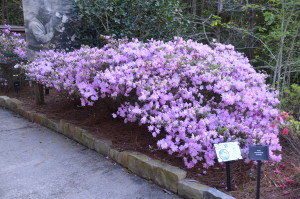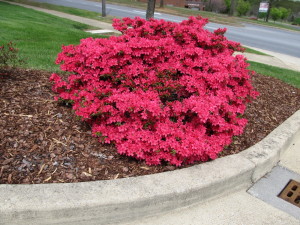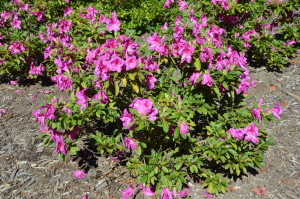Evergreen azaleas (Rhododendron spp.) are actually small-flowered rhododendrons. Depending on where you garden, azaleas enjoy a long bloom period from late March (zone 8) to June (zone 4) in the U.S. Many cultivars bloom for two weeks or more. Fall blooming types like Encore® and Bloom-a thon® series are also available.
Azaleas have shallow root systems and most of their feeder roots are near the surface. Dig shallow wide holes in well-drained soil that are amended with lots of organic matter. Water deeply after planting. Water your newly planted azalea weekly if the weather is dry, at least for the first year.
Fertilize azaleas in the spring or fall. Use a granular, slow-release fertilizer that is acid-forming. Established azaleas often do well with no fertilizer at all. If your soil is alkaline (pH>7), add iron sulfate or ammonium sulfate to lower pH to around 5.0. Mulch azaleas with shredded leaves, leaf mold, pine needles, or pine bark mulch keep the soil cool and moist. Shredded hardwood mulch tends to raise soil pH (less acidic).
Prune azaleas just after they finish flowering. Remove all dead, diseased, or weak branches. New buds for next spring’s flowers form in midsummer.
Azaleas shed some of their evergreen foliage naturally. Leaves may turn yellow, red, or purple before dropping. During unusually cold winters, some cultivars may drop more leaves than in mild winters. Flower buds can also be damaged by cold, dry winds. Deer and rabbits will browse over the winter months.
Common pest and disease problems:
Azalea lace bug appears anytime from spring to fall. Insecticidal soaps, horticultural oils, or systemic insecticides manage outbreaks of lace bugs.
If leaf edges are notched, black vine weevil may be the problem. The nocturnal feeding weevil larvae feed on azalea roots at night. Apply pesticide containing ingredient Imidacloprid to manage black vine weevils.
Azalea petal blight may show up when spring weather is unusually wet. Apply a fungicide labeled for petal blight just as the petals begin to show color.
Phytophthora or Pythium root rots may occur if soils are heavy clay and are poorly drained. Amending the soil to improve drainage may help or plant in raised beds.




 Posted in
Posted in 
